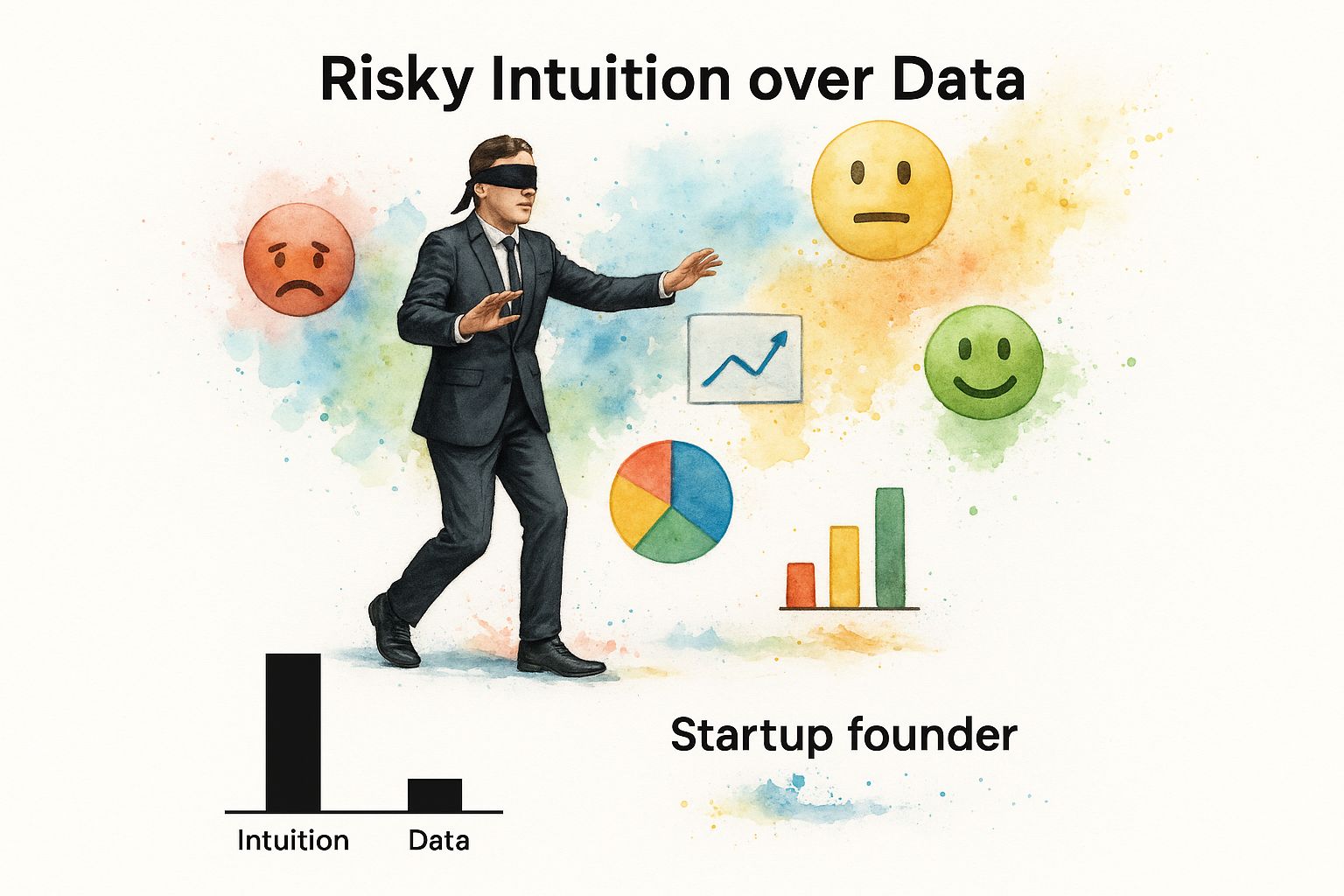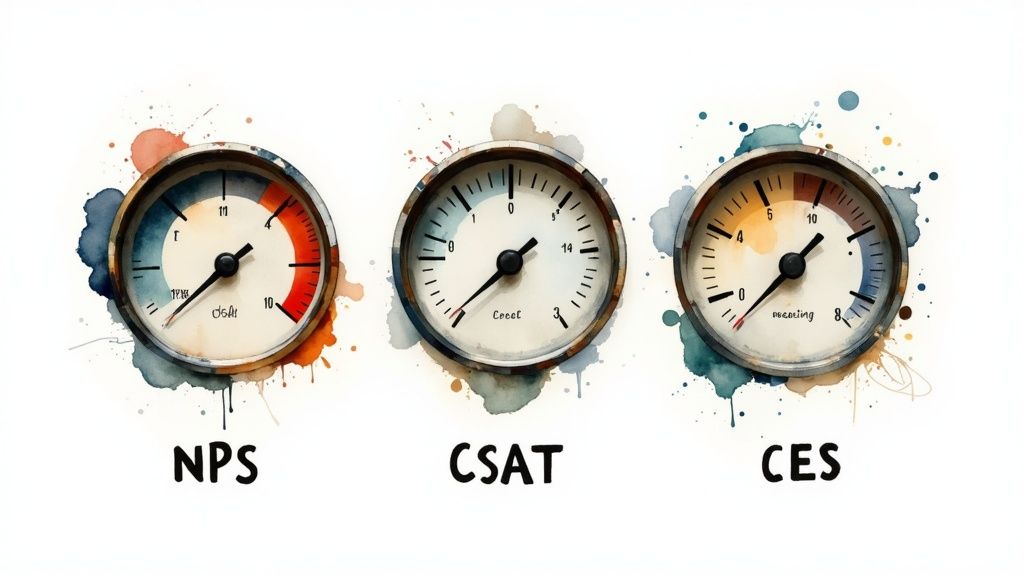Stop Guessing. Your Gut Feeling Is Killing Your Business.
Stop guessing. Learn how measuring client satisfaction drives growth. This founder's guide offers real strategies to get honest feedback and act on it.
Posted by
Related reading
Reputation Management Tools: The Secret Weapon Behind Loyal Customers & Higher Revenue
Reputation management tools help you track customer opinions, detect red flags early, and convert negative feedback into retention wins. See how they work & why feedback-driven SaaS like Backsy outperforms survey-only tools.
How to Collect Anonymous User Feedback (With Ready-to-Use Form Example)
Learn how to collect anonymous user feedback with higher honesty and lower bias. Includes examples, templates, and a ready-to-use feedback form you can embed instantly.
What Is Voice of Customer Service and How to Use It
Learn what Voice of Customer Service is and how to use the raw, unfiltered feedback from support channels to build a product that customers actually want.
Let's be blunt. Your intuition about what clients want is a liability. You think you've got the pulse because you had a few good calls and someone on Twitter said they "love the vision." That's a classic founder delusion, and it's a fast track to building something nobody will pay for.
Relying on vibes instead of data is like navigating a minefield blindfolded. Every step is a guess, and the odds are you'll step on something that blows your company to bits. Your assumptions are your biggest business risk; a system for measuring client satisfaction is the only insurance policy that pays out.
This infographic lays out the perilous journey of a founder who trusts their gut over data.

It perfectly captures the chaos of trying to read customer sentiment without a map. It’s a gamble you can't afford.
The Myth of the All-Knowing Founder
The startup world romanticizes the visionary who just knows. It’s a great story, but it's mostly fiction. For every one time that worked, a thousand other companies crashed and burned because their "vision" was a hallucination. The gap between what you think your customers want and what they actually want is where companies die.
You are not your customer. The features you obsess over are probably the ones they find confusing. That "killer" update you shipped could have broken a critical workflow for your highest-paying client. You won't know unless you ask, and you have to ask systematically.
Relying on intuition isn't bold; it's lazy. It’s choosing comfort over the messy, uncomfortable, and profitable truth buried in customer feedback.
And this isn't about making people happy. It’s about survival. You have to get over your own ego, a core principle of good business, whether you're evaluating client satisfaction or ditching the 'gut feeling' to overcome bias in other areas.
From Vague Hunches to Actionable Intelligence
So, what's the antidote to this self-inflicted blindness? A process. It means trading your ego for evidence. You have to build a machine that continuously feeds you the ground truth.
This machine doesn’t need to be complex. It starts with asking the right questions, at the right time, and—this is the critical part—having the guts to act on the answers, even when they sting. Understanding this feedback loop is the core of what data-driven decision-making really means. Ignore your customers, and you’ll be lucky to survive the quarter.
Takeaway: Stop treating your gut feeling like a business plan. It's a liability waiting to bankrupt you.
The Only Three Satisfaction Metrics That Matter

Forget the ocean of vanity metrics. You only need to master three core methods for measuring client satisfaction. Get these right, and you’ll know more than 90% of your competitors. Get them wrong, and you're just collecting noise.
The big three are Net Promoter Score (NPS), Customer Satisfaction (CSAT), and Customer Effort Score (CES). This isn't a textbook definition; it's a field guide from the trenches.
Your Go-To Metrics Explained
Think of these as different tools. Using a hammer to turn a screw is stupid. So is sending an NPS survey after a support ticket is closed.
Net Promoter Score (NPS): Your brand health check. Answers: "Are we building a tribe of fans or a mob of assassins?" You ask, "How likely are you to recommend us?" It’s a macro view, not a magnifying glass.
Customer Satisfaction (CSAT): Your real-time temperature check. Answers: "Did we screw up that one thing?" It’s a quick pulse on a specific interaction, like after a support chat ends. It’s transactional, immediate, and brutally honest.
Customer Effort Score (CES): The silent killer. Answers: "How much of a pain in the ass was it to get your problem solved?" A high effort score is a massive leading indicator of churn, even if your other metrics look okay.
A customer can be "satisfied" and even "likely to recommend" you, but if your product feels like wading through mud, they will ditch you the second a slicker alternative appears. High effort is a slow poison.
NPS vs CSAT vs CES: A No-BS Breakdown
Founders trip over this constantly. Print this out. Stop using the wrong tool for the job.
| Metric | Measures | When to Ask | Common Founder Mistake |
|---|---|---|---|
| NPS | Overall loyalty & brand health. | Periodically (e.g., quarterly) or after key milestones. | Asking too early. A new user can't recommend you; they barely know you. |
| CSAT | Immediate satisfaction with a single interaction. | Right after the event (purchase, support chat, etc.). | Using it to measure overall loyalty. A 5-star rating on a ticket isn't brand love. |
| CES | Ease of getting something done. | Immediately after a user has to do something. | Ignoring it. High effort kills loyalty faster than anything, yet it’s often overlooked. |
Bottom line: NPS tells you if they love you. CSAT tells you if you did a good job just now. CES tells you if you made them work too hard for it.
Don't Be an Idiot When You Deploy Them
Context is everything. Misusing these tools gives you garbage data that leads to terrible decisions.
Imagine a user just finished your onboarding. Sending an NPS survey is pointless. They can’t recommend a brand they don't have a relationship with. A CSAT survey asking "How satisfied were you with onboarding?" is perfect. It’s specific and actionable.
Later, after they’ve used your product for a month and submitted a support ticket, CES shines. Ask, "How easy was it to get your issue resolved?" If it was a nightmare, you have a support process problem, not a product one. The dirty little secret is that simply being satisfied isn't enough. People might be content, but they aren't committed. These three are your foundation, but don't get distracted by other actionable customer satisfaction measurement methods until you've mastered them.
Takeaway: NPS is your relationship score, CSAT is your transaction score, and CES is your friction score. Use the right tool for the job.
How to Ask Questions That Get Real Answers
Your survey questions suck. They're loaded with corporate jargon, lead the witness like a bad lawyer, or are so long they feel like homework. All of which guarantees you'll either be ignored or get polite, useless answers.
Stop asking, “How can we improve?” It’s a lazy question that puts all the work on the customer. They’ll either say something vague like “better support” or just close the tab. You get nothing.
The Art of the Follow-Up Question
The gold is never in the initial score. An NPS of 8 is just a number. It's the answer to the next question—the "why"—that matters.
This is where you pair your quantitative score with a single, sharp, open-ended question. The score is the signal; the follow-up is the story.
Bad questions get you vanity metrics. Good questions give you a roadmap. Stop asking questions that make you feel good and start asking ones that make you think.
Instead of vague, high-level questions, get surgical. Force them to think about a single, tangible moment. If you want to sharpen your skills, our guide on how to write open-ended questions will give you the tools.
Question Teardown: Bad vs. Killer
Here’s how to turn garbage questions into treasure maps.
Bad Question: “How would you rate our customer support?”
- Why it sucks: Too generic. Invites a thoughtless 1-5 score with zero context.
Killer Question: “Think about your last support interaction. What’s one thing we could have done to solve your issue 10 minutes faster?”
- Why it works: Forces recall of a specific event and provides a concrete suggestion. You’ll get answers like “put the chat button on the billing page” instead of “support was slow.”
Bad Question: “What features are you missing?”
- Why it sucks: Turns your customer into an unpaid product manager and opens the floodgates for a wish list you can't build.
Killer Question: “What’s the most frustrating task to complete with our product right now?”
- Why it works: Uncovers friction in your existing product. Fixing this is almost always more valuable than chasing new features.
Don't Mess Up the Delivery
The channel matters. A lot. A 10-question survey via SMS should be a fireable offense.
- In-App: Perfect for quick, contextual questions (CSAT/CES) right after an action.
- Email: Better for relationship-level feedback (NPS) when the user has a moment to think.
- SMS: Only for hyper-urgent, simple, yes/no interactions. Use with extreme caution.
Your goal is to make giving feedback effortless. Lower the friction, sharpen the question, and the real answers will roll in.
Takeaway: Stop asking for opinions and start hunting for specific moments of pain or delight.
Turning Raw Feedback into Your Secret Weapon

So you've got a spreadsheet full of raw, unfiltered comments. Nice. Most founders let this data die a slow death in a forgotten Google Sheet. They glance at it, nod, and go back to building whatever feature they already wanted to build.
Not us. We turn that jumble into a strategic advantage. This is Voice of Customer (VoC) analysis without the MBA jargon.
Raw feedback is messy. Your job isn't to chase every comment. It's to find the patterns. One person complaining is an anecdote. 50 people complaining about the same thing? That’s a fire you need to put out. Yesterday.
Triage Feedback Like an ER Doctor
You can't fix everything at once. Triage all incoming feedback into three buckets. Don't overcomplicate it.
- Code Red Bugs: Things that are actively broken. "I can't log in." "My payment failed." These are emergencies costing you money right now.
- Feature Friction: The product works, but it’s a pain. "The checkout process has too many steps." This is gold for slashing your churn rate.
- "Someday, Maybe" Ideas: Feature requests and blue-sky ideas. "Integrate with my smart toaster." Park these. Don't let them distract you from the fires.
This simple sorting transforms chaos into an actionable to-do list. If 20% of your detractors mention the "confusing checkout process," you have a revenue leak that needs plugging, fast.
Quantify the "Whys"
The real insights are buried in the qualitative comments. You have to roll up your sleeves. The goal is to turn unstructured text into something you can count. This is a core part of learning how to analyze qualitative data without getting lost.
Create simple tags for common themes: UI-Confusing, Billing-Error, Slow-Loading, Pricing-High. As you review feedback, apply the tags. Soon, a bar chart forms in your head. "Wow, UI-Confusing is getting mentioned three times more than anything else." Just like that, you have a mandate from your users.
The Power of Closing the Loop
Now for the part everyone skips: responding. When a customer tells you what’s wrong, they’re throwing you a lifeline. Ignoring it is spitting in their face.
A simple, human reply goes a long way. "Hey, I'm the founder. I read your feedback. You're right, that checkout flow sucks, and we're already fixing it," can turn a detractor into a fan.
Don't underestimate this. A staggering 70% of customers will ditch a brand after just two bad interactions. These moments are make-or-break.
Feedback isn't a report card to be filed away. It's a direct order from the people who pay your bills.
Ignoring your most vocal critics is a rookie move. Engaging them is how you build a cult.
Takeaway: Stop admiring feedback in a spreadsheet and start triaging it into bugs, friction, and ideas to build a roadmap your customers actually want.
Stop Admiring the Problem and Start Fixing It
Data is worthless unless it forces you to act. A pretty dashboard with a plunging NPS score doesn't fix a thing. It’s like staring at a leaky pipe, admiring the puddle instead of grabbing a wrench. Measuring client satisfaction isn’t an academic exercise—it’s the engine for your company’s growth, but only if you turn the key.
This is where you build a rhythm around client feedback. You need a direct, unbreakable line from a client's complaint to a developer's sprint.
From Dashboard to Dev Team
Forget complex reports nobody reads. You need a simple, weekly feedback summary your team can digest.
It should highlight three things, and only three things:
- The Biggest Fire: The top bug costing you users or money right now.
- The Worst Friction: The single most-mentioned frustration point in the product.
- The Unexpected Win: One piece of positive feedback to learn from and double down on.
This goes to everyone: product, engineering, support, marketing. When a developer sees a direct quote from a user saying, "this button is so confusing I almost gave up," it hits differently than a sterile Jira ticket. It connects their code to a real human’s frustration.
A dashboard is a rearview mirror; it shows you where you've been. A feedback loop is a GPS; it shows you the turn you need to take to avoid a crash.
Tying Satisfaction to Your Bank Account
Still think this is soft stuff? Let’s talk money. The link between client satisfaction and financial performance isn’t a theory; it’s a fact. Banks in the top 20% for customer advocacy see their revenue grow 1.7 times faster. If you want hard numbers, dig into the research on client satisfaction and financial growth.
This isn’t just for big banks. For a SaaS business, improving your Customer Effort Score (CES) by just one point directly correlates to reduced churn. Why? Because when your product is easier to use, people don't shop for alternatives. You’re not fixing a UX issue; you’re patching a hole in your recurring revenue.
Takeaway: Stop treating feedback like a report card and start treating it like a set of battle instructions from your paying customers.
Your feedback is a goldmine of growth hacks, so stop staring at the data and start digging with Backsy to find the insights that actually make you money.
Burning Questions I Get Asked All The Time
Let's skip the fluff. Here are the questions founders ask, with the straight answers you need.
How Often Can We Survey Customers Before They Get Pissed Off?
The question isn't about the calendar; it's about context. People don't mind giving feedback if the timing makes sense.
Ask for a CSAT score right after a specific interaction—like a closed support ticket. Ask for NPS once every 6 to 12 months. The key is to make the request feel relevant, not random. An in-app survey after a customer successfully uses a new feature? Smart. A generic email blast begging for feedback? That's spam.
Rule of thumb: If your request for feedback doesn't connect to an immediate experience the customer just had, you’re just interrupting them.
If I Only Have Time for One Metric, What Is It?
There isn't a magic bullet. Anyone who tells you otherwise is selling something.
But if I had to pick one to start with, I’d go with Customer Effort Score (CES). A customer can say they're "satisfied" (CSAT) or even "recommend" you (NPS), but if using your product feels like a chore, they are quietly looking for an exit. High effort is a silent killer. It creates a slow drain of customers who just get tired of the friction. Start there.
My Team Thinks This Is a "Nice-to-Have." How Do I Get Buy-In?
Forget motivational speeches. Show them how customer feedback makes their specific jobs easier.
Make it personal and impossible to ignore.
- Show your Head of Product screen recordings of users rage-clicking on a button they thought was perfectly designed.
- Present your sales leader with direct quotes from high-value customers who churned, explaining exactly why they left.
- Give your engineers data showing they spent three sprints building features nobody is using.
When you connect customer frustration to wasted time and lost revenue, your team stops seeing it as a distraction. They'll start asking for the data themselves.
The Bottom Line: Your customers are sitting on the answers to your biggest growth problems. Stop guessing and start asking.
Stop treating your customer feedback like an item on a to-do list and use Backsy to turn it into your most unfair competitive advantage.